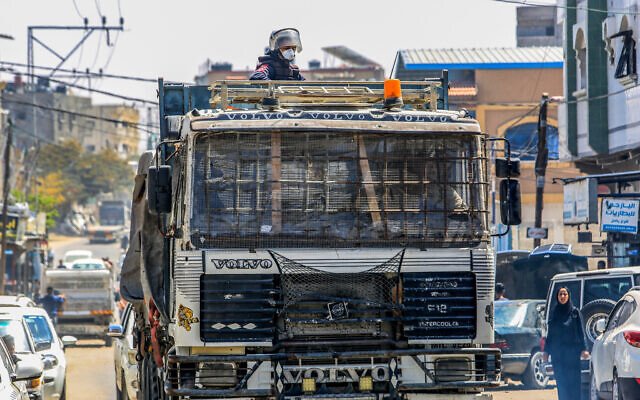
|
Getting your Trinity Audio player ready...
|
The Coordinator for Government Activities in the Territories (COGAT) reported a record-breaking influx of aid into the Gaza Strip on Sunday, marking the highest one-day total since the commencement of the war.
A total of 322 aid trucks entered Gaza, underscoring Israel’s commitment to addressing the humanitarian crisis in the besieged enclave.
COGAT, the Defense Ministry body responsible for coordinating Israeli activities in Palestinian territories, emphasized that there is no limit to the aid that can enter Gaza.
However, the surge in aid deliveries on Sunday appears to be a response to mounting international pressure on Israel to alleviate the dire humanitarian situation in Gaza.
Of the aid trucks that entered Gaza on Sunday, approximately 70 percent were loaded with essential food supplies, crucial for addressing widespread food insecurity in the territory.
In a related development, Israeli Defense Minister Yoav Gallant and US Ambassador to Israel Jack Lew conducted a tour of the Israeli Defense Forces’ (IDF) newly established Humanitarian Coordination and Deconfliction Cell.
This initiative, launched earlier in the week, is part of a series of measures aimed at improving the living conditions of Palestinians in Gaza.
Gallant, speaking during the tour, acknowledged the importance of facilitating the delivery of humanitarian aid to Gaza while reiterating Israel’s overarching objectives in the conflict, namely the dismantling of Hamas and the safe return of hostages.
“As we work to achieve the goals of this war, namely the destruction of Hamas and the return of the hostages, we recognize the importance of facilitating the delivery of humanitarian aid to Gaza,” Gallant stated, emphasizing the dual commitment to security objectives and humanitarian assistance.
The unprecedented scale of aid delivery comes amidst escalating international concern over the humanitarian crisis in Gaza, exacerbated by the ongoing conflict.
Calls for increased humanitarian access and efforts to alleviate suffering have intensified, with international actors exerting pressure on all parties involved to prioritize the well-being of civilians caught in the crossfire.
While the surge in aid deliveries represents a positive step towards addressing immediate humanitarian needs, significant challenges persist. Gaza continues to grapple with severe shortages of essential goods and services, compounded by extensive damage to infrastructure and limited access to medical care.
The United Nations and various humanitarian organizations have repeatedly underscored the urgent need for sustained humanitarian assistance and unfettered access to deliver aid to Gaza’s population, particularly in light of the protracted conflict and its devastating impact on civilian lives.
As efforts to broker a ceasefire and pursue diplomatic avenues for resolving the conflict continue, the provision of humanitarian aid remains a critical priority.
The international community, including Israel and its allies, faces mounting pressure to uphold humanitarian principles and ensure that assistance reaches those most in need amid the ongoing crisis in Gaza.
In the face of complex challenges and competing priorities, the surge in aid deliveries represents a tangible expression of commitment to addressing the humanitarian crisis in Gaza.
However, sustained efforts and meaningful cooperation will be essential to effecting lasting improvements in the lives of Palestinians in Gaza beyond the immediate delivery of aid.
This article was created using automation and was thoroughly edited and fact-checked by one of our editorial staff members


